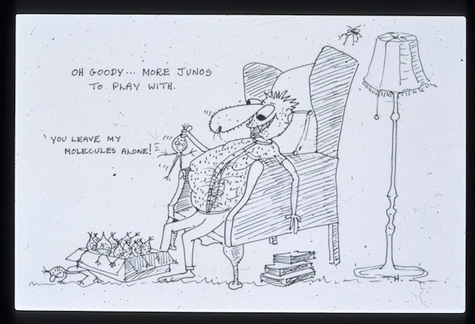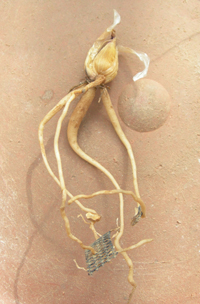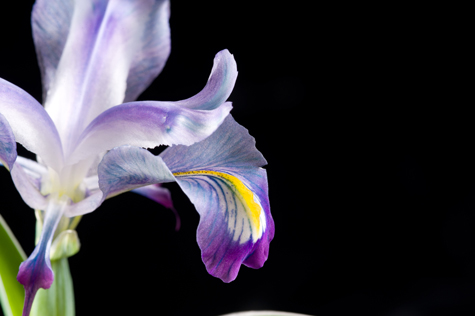Human Flower Project
Widely Winged
After years of assiduous transnational work, botanists at Kew coax an iris into bloom for the first time.

Iris stocksii bloomed in cultivation for the first time 1/23/12, at the Royal Botanic Gardens at Kew.
Photo: Andy McRobb
We imagine Tony Hall swinging through the door of a hospital maternity ward: “It’s an Iris stocksii!”
Congratulations to Tony, to Kit Strange, Juan Piek and everyone else involved in finding the rare bulbs in Afghanistan and handling them with such wisdom and care that the first flowered last month at the Royal Botanic Gardens at Kew. (And our thanks to Allen Bush for informing us all along the way.)
We are delighted and grateful to post in full Tony Hall’s fine description of this beautiful flower, its “gestation” and birth. A more complete scientific description may be found here.
If you’ve ever wondered how a top notch working horticulturist thinks (hyper-observant, meticulously historical), this account is revealing. (We’ve taken the liberty of dividing Hall’s four paragraphs into shorter passages for ease of reading online.)

Self-portrait of a juno iris expert, Tony Hall
Image: Courtesy of Tony Hall
Iris stocksii flowers at Kew
By Tony Hall
“I observed two flower buds forming on one plant of Iris stocksii in late December 2011. I had not expected such recently collected bulbs (2010) to flower so soon, especially as this species come from a semi-desert habitat with searing hot summers (in my experience, junos from such regions are notoriously difficult to maintain and flower, e.g. Iris postii & I. edomensis from the Middle East). However, our hero Juan Piek had very carefully cared for and packed his bulbs before despatch so that, although the fragile storage roots were detached (which invariably weakens bulbs), the bulbs arrived at Kew in remarkably good condition.
An image of one of the bulbs of I. stocksii, taken by Kit Strange in September 2011, during repotting, shows how well its rootstock, with newly formed slightly fleshy roots, had recovered during its first year in cultivation. Kit is our Bulb Horticulturist in the Alpine Unit at Kew, who repots and cares for the juno collection from day to day, with some guidance and advice from me. The 1st flower opened fully at Kew on the 21st January 2012, and was taken to Kew’s photographic studio for Andy McRobb to photograph three days later.
 Bulb of Iris stocksii, a year after arriving at Kew, showing newly formed fleshy roots, September 2011
Bulb of Iris stocksii, a year after arriving at Kew, showing newly formed fleshy roots, September 2011
Photo: Kit Strange
“Iris stocksii is well represented in herbaria although it has never been successfully cultivated before, as far as I can ascertain. Furse’s material of the closely related I. odontostyla was grown for a time and even flowered, in the late 1960s/early 1970s, at both R.H.S. Gardens, Wisley, and in the private collection of the late Dr. Jack Elliott, a very skilled grower of bulbous plants. Alas, few of those Paul Furse juno iris treasures from Afghanistan, collected in the 1960s, nor the slightly later collections of Kit Grey-Wilson & Tom Hewer, are still around and that includes I. odontostyla.
“Iris odontostyla is represented by a single type specimen in Kew’s Herbarium, although that is accompanied by wonderful notes and line drawings executed by Furse in the wild; unfortunately, the capsule and seed characters of I. odontostyla are unknown, but this taxon is likely to have non-arillate seeds like I. stocksii.
“Iris odontostyla appears to be restricted to Herat Province in W. Afghanistan, whilst I. stocksii, although found in this Province, has a much wider distribution in W., E. & S.E. Afghanistan; it also occurs in adjacent Pakistan (N. Baluchistan).
“It is worth comparing the colour image of I. odontostyla in the British Iris Society’s 1968 Year Book with Juan Piek’s plant of I. stocksii…they are remarkably similar in overall habit and flower colour, although the former is said to have slightly more greyish tints to its flowers and its outer tepals (or falls) a slightly different outline, and not so widely winged as in I. stocksii.
“Another distinguishing feature of I. odontostyla (as its specific epithet suggests) is irregularly toothed or scalloped style lobes, but Andy McRobb’s images show clearly that this feature can be observed in I. stocksii as well.

Close-up: the flower parts of Iris stocksii, January 26, 2012
Photo: Andy McRobb
“The chromosome count and karyotype of Iris stocksii were unknown, but have now been studied at Kew’s Jodrell Laboratory by Jaume Pellicer; I. stocksii has a count of 2n=20.
“We were also able to sacrifice a few of Juan’s original seeds for DNA extraction, in time to be added to our molecular study of the junos (Ikinci, N. et al. 2011. Molecular phylogenetics of the juno irises, Iris subgenus Scorpiris (Iridaceae), based on six plastid markers. Bot. Journ. Linn., 167 (3), 281-300). This study shows that I. stocksii falls into a small clade of rather distantly related species, primarily from the Hindu-Kush, which includes Iris cycloglossa and I. aitchisonii. Probably I. microglossa also belongs here but is unresolved in the analysis, as well as I. odontostyla, which was not available to sample.”

